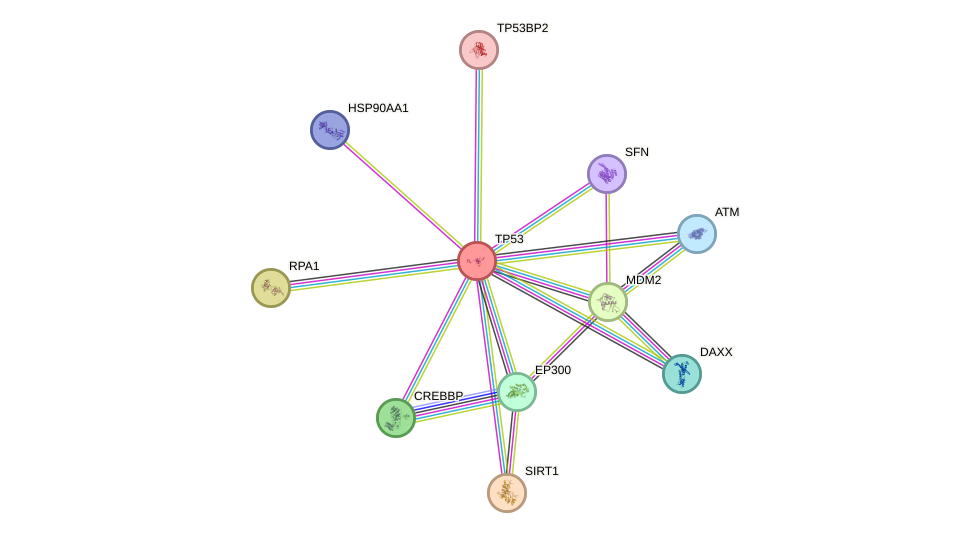GenAge entry for TP53 (Homo sapiens)
Entry selected based on evidence directly linking the gene product to ageing in a mammalian model organism
Gene name (HAGRID: 6)
- HGNC symbol
- TP53
- Aliases
- p53; LFS1
- Common name
- tumor protein p53
Potential relevance to the human ageing process
- Main reason for selection
- Entry selected based on evidence directly linking the gene product to ageing in a mammalian model organism
- Description
TP53 is a tumour suppressor involved in cell cycle regulation, apoptosis, and DNA repair [88]. Several lines of evidence from model organisms link TP53 to ageing, in agreement with its DNA damage protection role.
In flies, expression of a dominant-negative version of TP53 extends lifespan [1567]. Mice with a permanently activated form of TP53 display signs of premature ageing starting at about 18 months of age [11], as do mice heterozygous for TP53 that lack BRCA1 [37]. Overexpression of p44 (one of the short isoforms of p53) also causes a progeroid phenotype [1146], including phosphorylation of tau, synaptic deficits, and cognitive decline [3587]. Additionally, levels of p44 increase with age in the mouse brain [3587]. However, increased but regulated TP53 and CDKN2A activity has been found to ameliorate age-associated central nervous system functional decline in mice, acting to maintain the stem cell pool. This regulated TP53 activity provides a mechanism for extended lifespan and also health span in mice [4333].
Human mutations in TP53 have been associated with cancer [92]. People with a polymorphism that decreases the apoptotic potential of TP53 have increased survival despite a higher proportional mortality from cancer [1290]. The myriad of functions and interactions of TP53, as well as the findings from model organisms, make it a possible player in human ageing.
Cytogenetic information
- Cytogenetic band
- 17p13.1
- Location
- 7,668,401 bp to 7,687,550 bp
- Orientation
- Minus strand
Protein information
- Gene Ontology
-
Process: GO:0000122; negative regulation of transcription from RNA polymerase II promoter
GO:0000733; DNA strand renaturation
GO:0006284; base-excision repair
GO:0006289; nucleotide-excision repair
GO:0006355; regulation of transcription, DNA-templated
GO:0006366; transcription from RNA polymerase II promoter
GO:0006461; protein complex assembly
GO:0006974; cellular response to DNA damage stimulus
GO:0006977; DNA damage response, signal transduction by p53 class mediator resulting in cell cycle arrest
GO:0006978; DNA damage response, signal transduction by p53 class mediator resulting in transcription of p21 class mediator
GO:0006983; ER overload response
And 60 more GO terms Cellular component: GO:0000790; nuclear chromatin
GO:0005634; nucleus
GO:0005654; nucleoplasm
GO:0005657; replication fork
GO:0005669; transcription factor TFIID complex
GO:0005730; nucleolus
GO:0005737; cytoplasm
GO:0005739; mitochondrion
GO:0005759; mitochondrial matrix
GO:0005783; endoplasmic reticulum
GO:0005829; cytosol
And 5 more GO terms
Show all GO termsFunction: GO:0000977; RNA polymerase II regulatory region sequence-specific DNA binding
GO:0000981; RNA polymerase II transcription factor activity, sequence-specific DNA binding
GO:0001046; core promoter sequence-specific DNA binding
GO:0001085; RNA polymerase II transcription factor binding
GO:0001228; transcriptional activator activity, RNA polymerase II transcription regulatory region sequence-specific binding
GO:0002020; protease binding
GO:0002039; p53 binding
GO:0003677; DNA binding
GO:0003682; chromatin binding
GO:0003684; damaged DNA binding
GO:0003690; double-stranded DNA binding
And 21 more GO terms
Protein interactions and network
- Protein-protein interacting partners in GenAge
- TP53, TERT, ATM, ERCC2, ERCC8, WRN, LMNA, IGF1R, TXN, HRAS, MYC, EGFR, PRKCD, PLCG2, PARP1, BRCA1, PIN1, PTEN, CREBBP, HIF1A, NCOR1, RPA1, BLM, BCL2, S100B, HSP90AA1, EGR1, ABL1, BRCA2, TOP2A, TOP2B, TOP1, RAD51, UBE2I, ERCC6, STK11, EP300, PML, GSK3B, HTT, EEF2, ERCC3, PRKDC, AR, PCNA, XRCC6, HSPA8, BAX, RB1, FOXO3, UCHL1, SIRT1, HDAC1, HSPA1A, HSPA1B, PCMT1, MAPK8, YWHAZ, PTK2, MAPK14, SP1, MED1, MAPK9, MAPK3, HMGB1, CCNA2, BMI1, EEF1A1, TFAP2A, CREB1, TBP, APEX1, PTGS2, HSPA9, SIN3A, CDK1, TFDP1, HDAC2, MDM2, TAF1, POLA1, RELA, VCP, UBB, SUMO1, H2AFX, NR3C1, APTX, ESR1, NFKBIA, MTOR, CDKN2A, DBN1, PPP1CA, TP63, RAE1, ATR, CSNK1E, STUB1, CHEK2, CDC42, PPARGC1A, SIRT7, TP53BP1, BAK1, TP73, CDKN1A, MIF, IKBKB, SQSTM1, CDK7
- STRING interaction network
Retrieve sequences for TP53
Homologs in model organisms
In other databases
- GenAge model organism genes
- A homolog of this gene for Mus musculus is present as Trp53
- LongevityMap
- This gene is present as TP53
- CellAge
- This gene is present as TP53

